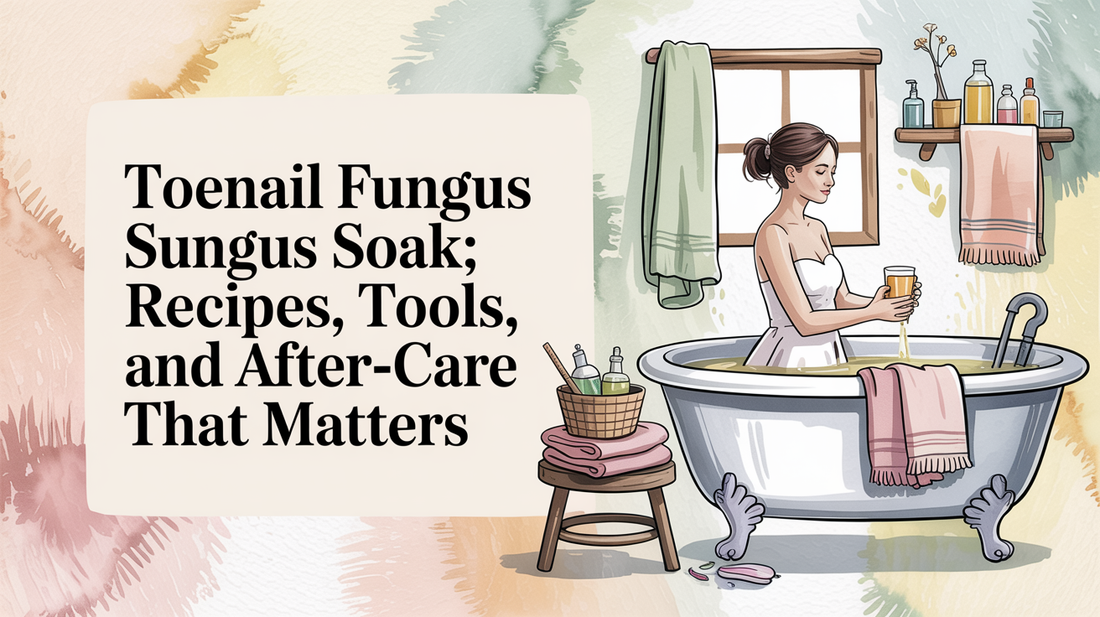Toenail Fungus Soak: Recipes, Tools, and After‑Care That Matters
toenail fungus soak, best soak for toenail fungus, foot soak antifungal — If you're dealing with toenail fungus, a soak might be the gentle remedy you're looking for. This post is structured into three sections that guide you in choosing the right soak, the tools you'll need, and the essential after-care. Let’s dive in and discover how you can take action tonight!
Choose Your Soak: Vinegar, Epsom, or Tea Tree 🧭
Foot soaks are a popular home remedy that may help combat toenail fungus with their natural antifungal properties. Each type of soak works differently by creating an environment that is less favorable for fungi to thrive. For instance, vinegar soaks, whether white or apple cider, can create an acidic pH that inhibits fungal growth and may help restore the skin's natural balance.
Epsom salt soaks draw out moisture from fungal cells while also softening the infected nail tissue, which can improve the treatment's penetration. Additionally, tea tree oil soaks, known for their antifungal properties, can effectively reach the nail beds when diluted properly.
- Vinegar soaks create an acidic environment that may help restore skin balance.
- Epsom salt soaks soften infected nails for better treatment absorption.
- Tea tree oil contains antifungal properties that reach deep into the nail.
- Combination soaks may enhance treatment effectiveness by addressing multiple fungal pathways.
- Consistency is key; soak daily for 15-30 minutes for gradual improvement.
Try It Tonight: Calm, Fresh Feet ✨
- Wash your feet with warm water and a mild cleanser; dry thoroughly between your toes.
- Apply a small amount of Kissable Feet where needed; massage until absorbed.
- Let your skin breathe; slip on breathable socks if desired. Patch-test first if you’re new to this foot cream.
Tools: basins, towels, socks, and sanitizing tips ✨
Having the right tools and maintaining hygiene are essential for an effective toenail fungus treatment. Non-porous basins, like those made from plastic or glass, are ideal as they don't react with acidic solutions and can be sanitized easily. Designate clean, absorbent towels solely for foot treatments to avoid spreading fungus.
Breathable cotton socks can help keep your feet dry after treatment, and antifungal socks made with copper or silver fibers can offer extra protection. Remember to sanitize your basin with a 10% bleach solution or 70% isopropyl alcohol between uses to eliminate any lingering fungal spores.
- Use non-porous basins for soaking to prevent reactions with solutions.
- Designate clean towels strictly for foot care to avoid spreading infections.
- Breathable socks maintain dryness post-soak; antifungal options are even better.
- Sanitize your soaking basin regularly for optimal hygiene.
- Monitor water temperature to keep it comfortable and effective.
Why We Recommend a Gentle Helper 🌿
Kissable Feet is designed for quick absorption and provides a soothing, non-sting experience. The blend of tea tree, coconut, and calendula offers comfort and a clean finish, making it easy to incorporate into your nightly routine.
- Fast-absorbing for a non-greasy feel.
- Gentle enough for sensitive, overworked feet.
- Bedtime-friendly scent keeps things fresh.
After‑care with Jane Vine Kissable Feet Foot Cream for soft, protected skin 🔍
After soaking, proper foot care is vital to maintain the benefits of your treatment and prevent reinfection. Quick drying is essential—pay special attention to the spaces between your toes to avoid moisture accumulation that might encourage fungal regrowth. Antifungal foot creams can provide continued protection in between treatments.
Look for creams with ingredients like tea tree oil or undecylenic acid, which may help support ongoing antifungal action. Additionally, moisturizing agents such as urea and glycerin can assist in repairing damaged skin, making sure to keep your feet hydrated without creating a breeding ground for fungi.
- Dry your feet immediately after soaking to prevent moisture buildup.
- Use antifungal creams regularly for continued protection.
- Incorporate moisturizing ingredients to repair and hydrate skin.
- Stay consistent with your application to maintain a protective barrier.
- Choose quality creams that are non-comedogenic and fast-absorbing.

